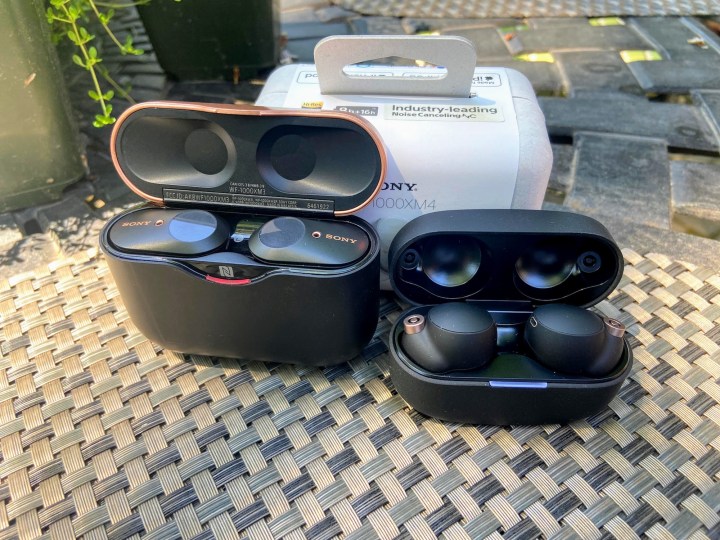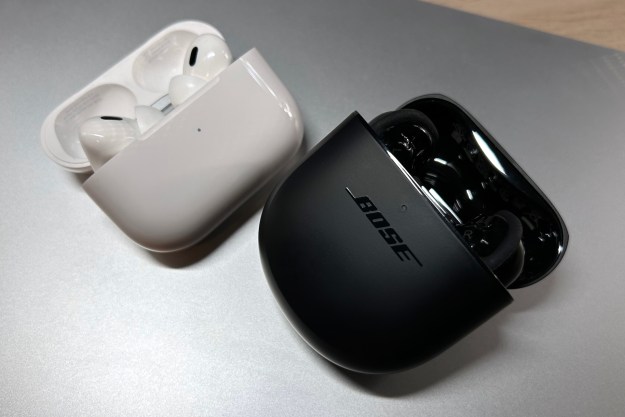
“With an all-new design and tons of improvements, they're very hard to beat.”
- Great sound quality
- Good battery life
- Great noise cancellation
- LDAC Bluetooth codec
- Wireless charging
- IPX4 water resistance
- May not fit small ears
- Slightly lacking in high-end detail
- No Bluetooth multipoint
Sony’s eagerly anticipated follow-up to its very highly rated WF-1000XM3 noise-canceling true wireless earbuds is finally here: The WF-1000XM4 cost $280, and they address even our very few critiques of the XM3 with a laundry list of improvements — some big, some small.
Has Sony once again established a new benchmark for the true wireless world, or does it still have some work to do? Let’s get into it.
Video Review
What’s in the box

First of all, big props to Sony for creating packaging that should be adopted as an industry standard. The XM4 come in a tiny box that eschews all the flashy labeling and glossy prints you’ll see on boxes from companies like JBL and Soundcore. As a result, every piece can be recycled or composted.
The only hint of plastic is in the thin exterior wrapping band that holds the two halves of the box together. Once opened, there’s no way to close it again, but I’m willing to bet most people discard their earbuds packages anyway, which is really the whole point.
Inside you’ll find the WF-1000XM4 already tucked into their charging case, a short USB-C charging cable, two extra sizes of foam eartips (the mediums are pre-installed), and some printed instructions.
Design

As much as we heap praise on the WF-1000XM3, they’ve always had one big caveat: They are among the bulkiest buds you can buy that aren’t specifically designed for aggressive workouts. That goes for the earbuds and their copper-topped charging case.
The WF-1000XM4 earbuds are 10% smaller than the XM3, which is good but not earth-shattering. The charging case, on the other hand, is 40% smaller, and it now has wireless charging as an option. That’s a big deal. The case still isn’t AirPods Pro small, but it’s no longer the odd man out when looking at the rest of the true wireless options. I’m now comfortable calling it a pocketable case — which I couldn’t say of the XM3.
The touch-sensitive control surfaces are now way easier to accurately tap.
The case lid opens easily and stays open on its own until you close it, which it does with a satisfying snap. But getting the earbuds takes a surprising amount of effort compared with the XM3 due to incredibly strong magnets and the tight shape of the charging socket. On the plus side, those magnets also grab the earbuds the moment they come close to the sockets, instantly and securely reseating them.
The other big change is the shape of the earbuds themselves. For years, Sony used the same capsule shape for its
I’m not generally a fan of touch controls, but the XM4 could make me a convert.
It’s also worth noting that Sony has addressed one of our other small gripes with the XM3: The lack of waterproofing. With an IPX4 rating, the XM4 are officially sweatproof for the gym or wherever else you need to take them.
Comfort, controls, and connections

I find the WF-1000XM4 quite comfortable to wear, but I’m not convinced everyone will agree. The new shape is designed to fit within your concha — the cavity that leads to the ear canal. But the XM4 are quite large. If you happen to have small ears, you might not be able to insert them all the way. The XM3, by comparison, have a much smaller in-concha “footprint,” to use an awkward metaphor.
The XM4 feel bigger in my ears than most of the top contenders, including the Jabra Elite 85t, Apple AirPods Pro, Master & Dynamic MW08, and JBL Tour Pro+.
The foam eartips conform to your ear shape better than silicone: You won’t have to struggle to find a set that fits.
If your ears can accommodate the XM4’s larger shape, you’ll be rewarded with a very secure fit. There’s a ton of surface contact, and once inserted, they won’t be going anywhere. They inspire much more confidence than their predecessors.
While the XM3 were available with silicone eartips, the XM4 exclusively come with memory foam. They conform to your ear shape better than silicone, which means you probably won’t have to struggle as much to find a set that fits. But they also create a stronger sense of having an object lodged in your ear canal, and they break down faster than silicone.
I’m not generally a fan of touch controls, but the XM4 could make me a convert. The generous size of the touch pads makes taps easy, accurate, and quick.
I’m less enthusiastic about Sony’s control customization scheme, which it has kept from the XM3. The Headphones app groups controls by function: Ambient, playback, volume, and none. Because each earbud can be assigned to only one control group, you have to pick your favorite two. Want to control playback and volume? You won’t be able to switch ANC modes. Like ANC control and also playback? Volume is no longer available. JBL does the same thing, so it’s not like this situation is unique to Sony, but I’d prefer more a-la-carte flexibility.
There is a workaround, at least for Android users. The XM4 enable wake-word access to both Google Assistant and Alexa when using a phone with
Wear sensors let you auto-pause and resume playback when you remove or reinsert the earbuds, and they work really well, rapidly responding to changes. If it bugs you, you can disable it in the Headphones app.
The frequency response is strong from end to end, and there’s an incredible depth to the bass.
The excellent Bluetooth connection on the XM4 works very smoothly and allowed me to put 40 or 50 feet between the earbuds and my phone before the connection started to wobble. Unlike the XM3, which would occasionally give me tiny, half-second dropouts, the XM4 never missed a beat. I just wish Sony had found a way to include Bluetooth multipoint, which lets you connect the earbuds to two devices simultaneously. Sony’s full-size WH-1000XM4 can pull this off, but it’s still a rarity in the earbud world.
Sound quality

The WF-1000XM4 sound terrific. The frequency response is strong from end to end, and there’s an incredible depth to the bass. I guarantee that anyone who pops them in will enjoy their rich and full sound signature.
But as I jumped back and forth between the XM4 and the XM3, something became apparent: The XM3 exhibit clearer upper midranges and high frequencies that give vocals just a bit more presence. It also adds a level of energy that the XM4 seem to lack.
These observations are based on factory settings, with no EQ adjustments within the Sony Headphones app. Switching the XM4 to “Bright” or “Treble Boost” helps a little, but even then, I think the XM3 are better overall for clarity.
Will you notice this if you just listen to the XM4? I doubt it. It’s really only when you put the two side by side, listening to track after track, that it becomes apparent.
The XM4 are Sony’s first
To be clear, the difference between these two siblings is really a matter of taste. The XM4 do a better job of low-end detail, which you can really hear when songs layer bass guitar, drums, and low-end synthesizers on top of each other. All too often, those elements get smeared together, but the XM4 let you hear them distinctly, which is a real joy. So consider the XM4 an alternative interpretation of Sony’s excellent sound quality, but one that is geared toward those who want to hear extra detail in the low end.
Noise cancellation and transparency

Sony’s noise cancellation tech has always been excellent, and the WF-1000XM4 manage to improve on it. Sony claims the Integrated Processor V1 chip inside the XM4 improves on the XM3’s ANC performance across the board, diminishing external sounds throughout the
The XM4 aren’t just better at masking sound; they’re better at doing it invisibly.
One of my benchmark tests for ANC is to run my loud bathroom vent fan, which produces both low and high-frequency sounds. I then turn ANC on and off to listen to the differences and repeat the process at different distances. The XM4 ace this test, killing off close to 90% of the fan’s noise at a distance of 3 feet and 100% when I sit just outside the bathroom.
But the XM4 aren’t just better at masking sound; they’re better at doing it invisibly. Some ANC systems kill external sounds but introduce new ones, like a low-grade hiss that is
Apple’s AirPods Pro established a firm lead over the WF-1000XM3 in this arena, but the XM4 have once again leveled the playing field. But the XM4, even with Sony’s optional wind-noise reduction system, are still not as effective at canceling wind sound as the AirPods Pro.
Transparency mode is also more convenient to use thanks to the new speak-to-chat feature. It uses sensors to figure out when you’re speaking and automatically engages transparency mode while pausing your music. I found it worked really well. The Headphones app lets you toggle it on and off, adjust its sensitivity, and decide how long transparency should remain turned on after it detects your voice.
Battery life

When fully charged, Sony claims eight hours of play time with ANC turned on and an impressive 12 hours when it’s turned off — a big boost over the XM3’s capacity of six and eight hours, respectively. Several features, like wake-word access to voice assistants and wind-noise reduction, will reduce these numbers, but on the whole, I found they were accurate.
The XM4 also get a faster quick-charge option: A five-minute quick charge adds another hour of playback time, while the XM3 took 10 minutes to gain 90 minutes of playback. The charging case contains enough juice for two full charges, which gives a total listening time of at least 24 hours before you need to go in search of an outlet or wireless charging mat.
Voice assistant compatibility
Sony has always taken an agnostic approach to voice assistants on its headphones: You can choose to use your phone’s built-in assistant, or you can switch to Amazon Alexa or Google Assistant.
Call quality

Calling on the WF-1000XM4 is good. Most competing sounds, like traffic, are effectively neutralized, and so is wind noise, which was a weakness of the WF-1000XM3. It’s not perfect: As the earbuds attempt to correct for these external noises — especially wind — it can sound like you’re speaking through several layers of fabric. But since that’s preferable to listening to the annoying whistle of the wind, I think it’s an improvement.
When on a call, the earbuds automatically disengage ANC, but you can still decide to turn it back on or switch to transparency mode, something that not all earbuds let you do mid-call.
Our take
Sony has taken the already superb WF-1000XM3 and made meaningful improvements across the board with its new WF-1000XM4. Though the new shape may create fit problems for some, they’re among the best
Is there a better alternative?
Feature for feature, it’s hard to find a set of wireless earbuds that can truly compete with the WF-1000XM4, but there are better options for specific functions.
The AirPods Pro and Bose QuietComfort Earbuds are better for ANC and transparency, with the Bose shining especially brightly for call quality.
The Master & Dynamic MW08 deliver a more nuanced sound quality, with better clarity.
And now that Sony is still selling the WF-1000XM3 for a reduced price of $180, they’re still very much worth your consideration if you’re ok with some missing features like wireless charging and water resistance.
How long will they last?
Sony backs the WF-1000XM4 with a one-year warranty, but I expect they’ll last for many years. The build quality and materials are both excellent. The foam eartips will probably need to be replaced every six months with consistent daily wear, but that’s not unusual.
Should you buy them?
Absolutely. If you’re looking for wireless earbuds packed with awesome features, excellent ANC, and fantastic sound quality, you can’t go wrong with the WF-1000XM4.
Editors' Recommendations
- What is Sonos? The speakers, app, and everything you need to know about wireless music
- Sonos’ new Era 100 and Era 300 wireless speakers go all-in on spatial audio and Bluetooth
- Bluetooth Multipoint finally arrives on Sony’s best wireless earbuds
- Best headphones for 2023: Sony, Sennheiser, Apple, and more
- The first wireless hi-res headphones with UWB will arrive in 2024






